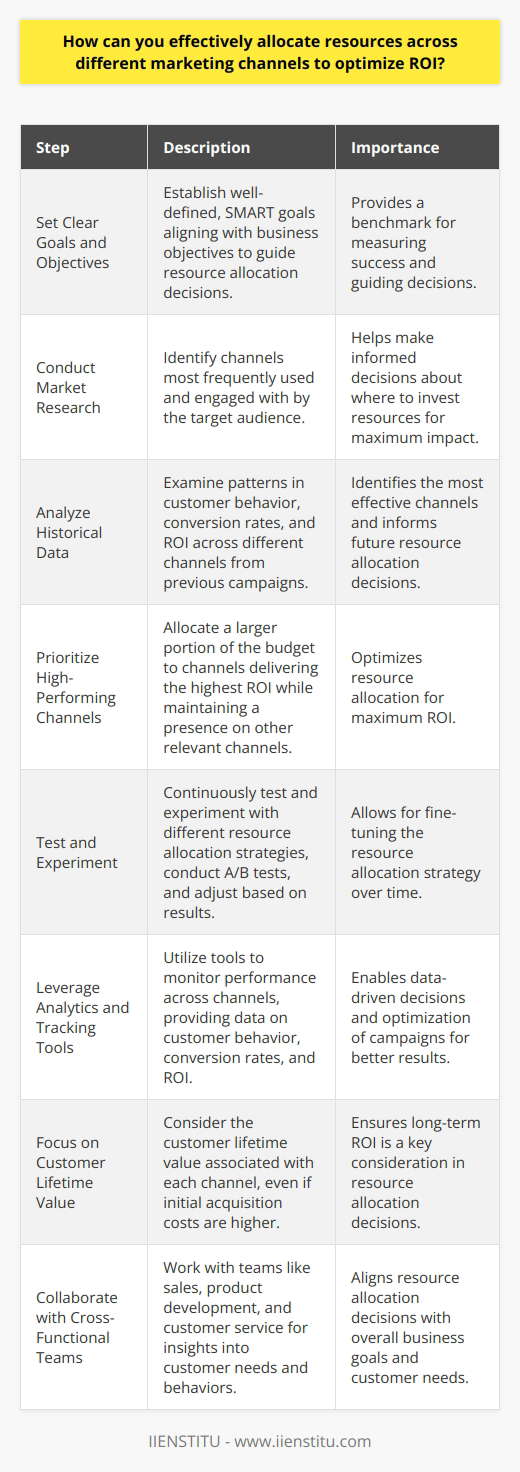
In today's digital landscape, businesses need to explore diverse and effective marketing strategies to stay ahead of the competition.
This is where the concept of diversifying digital marketing channels comes into play. It involves expanding your marketing efforts beyond a single platform to reach a wider audience and maximize your online presence.
Related Course: Digital Marketing Free Course
In this article, we will discuss why this interview question is asked, its purpose, the interview level it is asked, the expected answer from candidates, and possible answers to consider when addressing this question.
Why is this interview question asked: How Do You Diversify Digital Marketing Channels?
Digital marketing is an ever-evolving field, and staying up-to-date with the latest trends and techniques is crucial for success.
Hiring managers ask this question to evaluate a candidate's knowledge, experience, and creativity in employing various digital marketing channels effectively. It assesses their ability to think critically, adapt to changes, and drive results in an increasingly competitive online landscape.
The Purpose of the Question
The purpose of asking how to diversify digital marketing channels is to gauge a candidate's understanding of the diverse platforms available and their ability to leverage them strategically.
Interviewers want to know if the candidate can think beyond traditional marketing methods, explore new opportunities, and tailor their strategies to reach and engage their target audience effectively.
At What Interview Level is it Asked?
This question is typically asked at mid or senior-level interviews, where candidates are expected to have a solid foundation in digital marketing.
It is suitable for positions such as Digital Marketing Manager, Marketing Strategist, or similar roles where the candidate's expertise in diversifying digital marketing channels is crucial for driving business growth.
Strategies For Handling Supply Chain Disruptions During An İnterview
İnterview Question Tips For Global Digital Marketing Experience
What Kind of Answer is Expected from the Candidate?
When answering this question, the hiring manager expects the candidate to demonstrate a comprehensive understanding of various digital marketing channels and explain their strategies to diversify these channels effectively.
The answer should exhibit the candidate's ability to think creatively, identify target audience preferences, and choose the most appropriate platforms to deliver their message.
Possible Answers to Consider
Research and Understand Your Target Audience: Understanding your target audience's demographics, preferences, and online behavior is the cornerstone of effective digital marketing. Engage in market research and leverage tools like Google Analytics to gain insights into your audience's online habits. This data will help you identify the most relevant digital channels to reach them.
Consider Multiple Platform Strategies: Explore a mix of digital marketing channels that align with your target audience's preferences. This may include search engine optimization (SEO), social media marketing, email marketing, content marketing, influencer collaborations, video marketing, and paid advertising. Each platform has its unique strengths and can contribute to diverse marketing efforts.
Tailor Content for Each Channel: Adapt your content strategy to fit the specific requirements and nuances of each platform. For example, create compelling and shareable visuals for Instagram, produce informative blog posts for your website, and engage in meaningful conversations on relevant forums and communities. By customizing your content, you can maximize its impact on various channels.
Embrace Emerging Trends: Stay ahead of the curve by embracing emerging digital marketing trends. Keep an eye on the latest technologies, social media platforms, and consumer behaviors. For example, explore the potentials of TikTok, voice search optimization, and Augmented Reality (AR) experiences to diversify your marketing approach and reach untapped audiences.
Continuously Analyze and Tweak: Regularly evaluate the performance of your digital marketing campaigns across different channels. Analyze metrics such as click-through rates, engagement rates, conversion rates, and return on investment. Based on these insights, make data-driven decisions to refine your strategies, discard underperforming channels, and focus on those that yield the best results.
What to Consider When Answering
When answering this question, ensure that your response reflects an understanding of the specific needs and goals of the company you're interviewing with. Relate your strategies to their industry, target audience, and business objectives.
Additionally, emphasize the importance of tracking and measuring the performance of each channel, demonstrating your ability to provide tangible results and adapt your strategies accordingly.
Diversifying digital marketing channels is a vital aspect of a successful marketing strategy in today's digital era. By expanding your reach, leveraging various platforms, and tailoring your content, you can enhance your brand visibility, engage a wider audience, and drive business growth.
When answering this interview question, showcase your knowledge, expertise, and creativity in diversifying digital marketing channels, leaving a lasting impression on the hiring manager. Remember, staying adaptable and willing to embrace emerging trends is key to staying competitive in the dynamic world of digital marketing.
Digital Marketing Channel Options
Pros and Cons of Different Digital Marketing Channels
Strategies for Cross-Channel Promotions
Similar interview questions:
Multiple Choice Question: Which of the following techniques can diversify digital marketing channels?
a) Utilizing social media platforms
b) Incorporating email marketing campaigns
c) Leveraging search engine optimization (SEO)
d) All of the aboveTrue or False Question: True or False: Diversifying digital marketing channels helps in reaching a wider audience.
Fill in the Blanks Question: What strategies can businesses employ to _______ their digital marketing channels and enhance their online presence?
Short Answer Question: Name at least three different methods that businesses can utilize to diversify their digital marketing channels.
Matching Question: Match the appropriate digital marketing channel diversification strategy with its description.
A. Content marketing
B. Influencer partnerships
C. Paid advertising
D. Affiliate marketing
i. Collaboration with popular social media personalities
ii. Promoting products or services on search engine platforms
iii. Creating valuable and engaging blog articles
iv. Earning commission for driving traffic or sales through referralsMultiple Response Question: Which of the following are benefits of diversifying digital marketing channels? Select all that apply.
a) Expanding brand visibility
b) Increasing customer engagement
c) Maximizing conversion rates
d) Minimizing marketing costsOpinion/Reflection Question: In your experience, what are the key challenges businesses may face when diversifying their digital marketing channels, and how can they overcome them?
Yes or No Question: Is it necessary for businesses to regularly analyze and assess the performance of their diversified digital marketing channels?
Ordering Question: Arrange the following steps in the correct order to effectively diversify digital marketing channels.
a) Analyze target audience demographics
b) Develop a digital marketing strategy
c) Explore various advertising platforms
d) Implement tracking and analytics toolsMatching Question: Match each type of digital marketing channel with a suitable example.
A. Social media marketing
B. Display/banner advertising
C. Email marketing
D. Video marketing
i. Sending personalized newsletters to subscribers
ii. Running ads on news websites or blogs
iii. Creating engaging content on platforms like Facebook and Instagram
iv. Sharing promotional videos on platforms like YouTube and TikTok

Frequently Asked Questions
What is channel mix in digital marketing?
Channel mix in digital marketing refers to the combination of various digital channels used to reach and engage target audiences. It involves strategically selecting and integrating different online platforms to maximize brand visibility, customer interaction, and conversion rates. The goal is to create a cohesive and effective multi-channel approach that aligns with the overall marketing objectives and target audience preferences.
Key Components of Channel Mix
A well-designed channel mix typically includes a range of digital channels, each serving specific purposes and targeting different audience segments. These channels can be categorized into three main types: owned, earned, and paid media.
Owned Media
Owned media refers to the digital assets and platforms that a brand has complete control over. These include the company website, blog, social media profiles, and email newsletters. Owned media allows brands to create and distribute content, engage with customers, and build long-term relationships.
Earned Media
Earned media represents the exposure and publicity gained through organic means, such as word-of-mouth, online reviews, and social media mentions. It is essentially the digital equivalent of traditional public relations. Earned media is highly valuable as it carries credibility and authenticity, as it comes from third-party sources.
Paid Media
Paid media involves leveraging advertising platforms to reach a wider audience and drive targeted traffic. This includes pay-per-click (PPC) advertising, social media advertising, display ads, and sponsored content. Paid media allows brands to gain immediate visibility, target specific demographics, and scale their reach quickly.
Developing an Effective Channel Mix Strategy
Creating an effective channel mix strategy requires a deep understanding of the target audience, marketing goals, and available resources. Marketers need to consider factors such as audience demographics, online behavior, and platform preferences when selecting the most appropriate channels.
A data-driven approach is crucial in optimizing the channel mix. By analyzing metrics such as website traffic, engagement rates, and conversion rates, marketers can identify the best-performing channels and allocate resources accordingly. Continuously monitoring and adjusting the channel mix based on data insights ensures that the marketing efforts remain effective and adaptable to changing audience preferences and market trends.
Benefits of a Well-Designed Channel Mix
An optimized channel mix offers several benefits for businesses. It allows brands to reach a wider audience, improve brand awareness, and drive targeted traffic to their digital properties. By leveraging the strengths of each channel and creating a seamless user experience across platforms, businesses can enhance customer engagement and build stronger relationships with their audience.
Moreover, a well-designed channel mix enables marketers to maximize their return on investment (ROI) by allocating resources to the most effective channels. By continuously refining and adapting the channel mix based on performance data, businesses can ensure that their digital marketing efforts are cost-effective and aligned with their overall objectives.
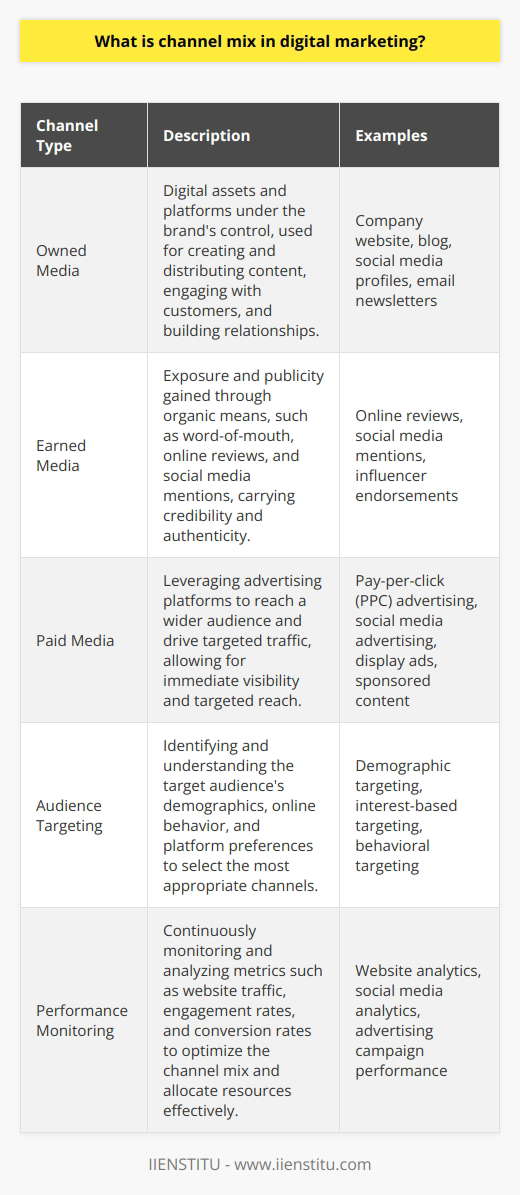
How can businesses optimize their digital marketing channel mix?
Businesses can optimize their digital marketing channel mix by carefully analyzing their target audience and marketing objectives. They should conduct thorough market research to identify the channels their potential customers frequently use and engage with. This research will help them allocate their marketing budget effectively across various digital platforms.
To create a successful digital marketing mix, businesses must develop a clear understanding of each channel's strengths and limitations. They should evaluate the potential reach, engagement rates, and conversion potential of each platform. By leveraging the unique characteristics of each channel, businesses can create a synergistic marketing strategy that maximizes their return on investment.
Tailoring Content for Each Channel
Businesses should tailor their content and messaging to suit the specific requirements and best practices of each digital channel. They must adapt their content format, tone, and style to resonate with the audience on each platform. For example, visually appealing images and short videos perform well on Instagram, while longer-form content is better suited for blog posts and email newsletters.
Continuously Monitor and Adjust
To optimize their digital marketing channel mix, businesses must continuously monitor the performance of each channel. They should track key metrics such as reach, engagement, click-through rates, and conversions. By regularly analyzing this data, businesses can identify which channels are delivering the best results and adjust their strategy accordingly.
Embrace an Omnichannel Approach
An omnichannel approach ensures that businesses provide a seamless and consistent experience across all digital touchpoints. They should integrate their marketing efforts across various channels, allowing customers to engage with the brand through their preferred platform. This approach helps build brand consistency, trust, and loyalty among the target audience.
Stay Updated with Emerging Trends
The digital landscape is constantly evolving, with new platforms and trends emerging regularly. Businesses must stay updated with the latest developments in digital marketing to remain competitive. They should be willing to experiment with new channels and tactics while closely monitoring their effectiveness. By staying agile and adaptable, businesses can optimize their digital marketing channel mix to drive better results.

What factors should be considered when developing a digital marketing channel mix strategy?
Developing a digital marketing channel mix strategy requires careful consideration of several key factors. First, businesses must identify their target audience and understand their preferences, behaviors, and online habits. This information will help determine which digital channels are most likely to reach and engage potential customers effectively.
Another crucial factor is the company's overall marketing objectives and goals. These may include increasing brand awareness, generating leads, driving sales, or improving customer retention. The chosen digital channels should align with these objectives and contribute to achieving the desired outcomes.
Budget and Resource Allocation
Budget and resource allocation also play a significant role in developing a digital marketing channel mix strategy. Companies must assess their available financial resources and allocate them wisely across various channels. They should consider the costs associated with each channel, such as paid advertising, content creation, and social media management.
Additionally, businesses must evaluate their internal capabilities and resources. This includes assessing the skills and expertise of their marketing team, as well as the time and effort required to manage and optimize each digital channel effectively.
Competitor Analysis and Industry Benchmarks
Conducting a thorough competitor analysis is essential when developing a digital marketing channel mix strategy. Companies should examine their competitors' online presence, marketing tactics, and success rates across different channels. This information can provide valuable insights into industry best practices and help identify opportunities for differentiation.
Furthermore, businesses should consider industry benchmarks and trends. Different industries may have varying levels of success with specific digital channels. For example, B2B companies may find LinkedIn more effective for lead generation, while e-commerce businesses may prioritize Instagram and Facebook for product promotion.
Customer Journey and Funnel Stages
Understanding the customer journey and mapping out the various funnel stages is crucial for selecting the right digital channels. Different channels may be more effective at different stages of the customer journey. For instance, social media and content marketing may be better suited for attracting and engaging prospects at the top of the funnel, while email marketing and retargeting ads may be more effective for nurturing leads and driving conversions.
Integration and Cross-Channel Optimization
When developing a digital marketing channel mix strategy, businesses must consider how the selected channels will integrate and work together. A cohesive and integrated approach ensures that marketing messages and campaigns are consistent across all touchpoints, providing a seamless customer experience.
Moreover, companies should continuously monitor and optimize their channel mix based on performance data and insights. Regular analysis of key metrics, such as engagement rates, conversion rates, and ROI, will help identify areas for improvement and enable data-driven decision-making.
In summary, developing a digital marketing channel mix strategy requires a holistic approach that takes into account target audience preferences, marketing objectives, budget and resources, competitor analysis, industry benchmarks, customer journey stages, and cross-channel integration. By carefully considering these factors and continuously optimizing their channel mix, businesses can create a powerful and effective digital marketing strategy that drives results and achieves their goals.

What are some channels of digital marketing?
Digital marketing encompasses various channels that businesses can utilize to reach and engage with their target audience online. These channels include search engine optimization (SEO), pay-per-click (PPC) advertising, social media marketing, email marketing, content marketing, and affiliate marketing. Each channel offers unique opportunities to connect with potential customers and promote products or services.
Search Engine Optimization (SEO)
SEO involves optimizing a website's content and structure to improve its visibility in search engine results pages (SERPs). By researching and targeting relevant keywords, creating high-quality content, and building quality backlinks, businesses can increase their organic traffic and attract more qualified leads.
Pay-Per-Click (PPC) Advertising
PPC advertising allows businesses to display ads on search engine results pages and other websites. Advertisers only pay when a user clicks on their ad, making it a cost-effective way to drive targeted traffic to a website. Google Ads and Microsoft Advertising are popular PPC platforms.
Social Media Marketing
Social media platforms like Facebook, Instagram, Twitter, and LinkedIn provide businesses with opportunities to engage with their audience. By creating and sharing valuable content, running targeted ads, and interacting with followers, businesses can build brand awareness, generate leads, and foster customer loyalty.
Email Marketing
Email marketing involves sending targeted, personalized messages to a list of subscribers. By segmenting their email list and delivering relevant content, businesses can nurture leads, promote products, and encourage repeat business. Email automation tools can help streamline the process and improve efficiency.
Content Marketing
Content marketing focuses on creating and distributing valuable, relevant, and consistent content to attract and retain a clearly defined audience. This can include blog posts, videos, infographics, ebooks, and webinars. By providing informative and engaging content, businesses can establish themselves as industry experts and build trust with their audience.
Affiliate Marketing
Affiliate marketing is a performance-based channel where businesses partner with third-party publishers (affiliates) to promote their products or services. Affiliates earn a commission for each sale or lead they generate through their unique referral link. This channel can help businesses expand their reach and drive sales without upfront costs.
To maximize the effectiveness of digital marketing, businesses should develop a comprehensive strategy that integrates multiple channels. By understanding their target audience and leveraging the strengths of each channel, businesses can create a cohesive and impactful digital marketing campaign that drives results.
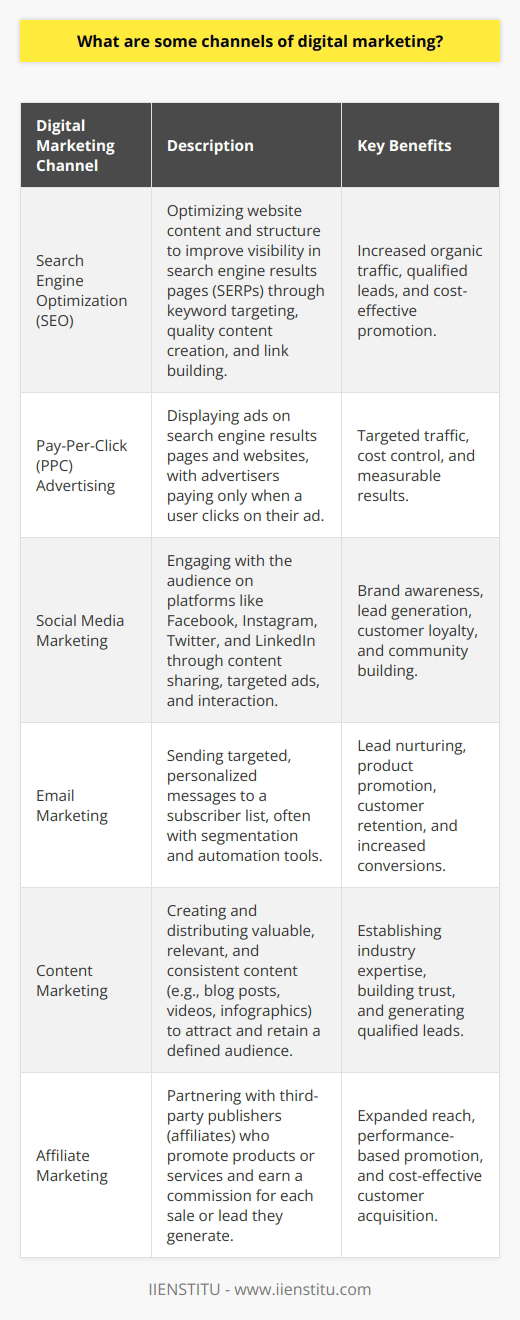
How can search engine optimization (SEO) benefit digital marketing efforts?
Search engine optimization (SEO) plays a crucial role in enhancing the effectiveness of digital marketing efforts. By implementing SEO strategies, businesses can improve their online visibility and attract more qualified traffic to their websites. This increased visibility leads to higher brand awareness, as potential customers are more likely to encounter the company's products or services when searching for relevant keywords.
Improved User Experience
SEO best practices also contribute to a better user experience on the website. Optimizing site structure, navigation, and content improves the ease of use for visitors. When users find the information they need quickly and easily, they are more likely to engage with the site and convert into customers. Additionally, search engines favor websites that provide a positive user experience, further boosting their rankings.
Keyword Research and Targeting
Effective keyword research is a fundamental aspect of SEO. By identifying the terms and phrases that potential customers use when searching for products or services, businesses can optimize their content accordingly. Targeting relevant keywords helps attract the right audience to the website, increasing the likelihood of conversions. Moreover, ranking well for these keywords can establish the company as an authority in its industry.
Long-term Cost-effectiveness
Compared to other digital marketing channels, such as paid advertising, SEO offers long-term cost-effectiveness. While paid ads provide immediate results, they require ongoing investment to maintain visibility. In contrast, SEO efforts build organic rankings that can generate sustained traffic over time. Once a website achieves high rankings for target keywords, it can continue to attract visitors without incurring additional costs.
Competitive Advantage
In today's digital landscape, SEO is essential for staying competitive. With numerous businesses vying for online attention, appearing at the top of search engine results pages (SERPs) can make a significant difference. By outranking competitors for relevant keywords, companies can capture a larger share of the target market. SEO helps level the playing field, allowing even small businesses to compete with larger enterprises.
Local SEO Benefits
For businesses with a local presence, SEO can be particularly beneficial. Optimizing for local search terms and establishing a strong online presence can attract customers searching for products or services in a specific area. Local SEO techniques, such as claiming Google My Business listings and building local citations, can improve visibility in local search results and drive foot traffic to physical stores.
Measurable Results
SEO provides measurable results, allowing businesses to track the success of their efforts. Through tools like Google Analytics, companies can monitor website traffic, keyword rankings, and conversion rates. This data helps identify areas for improvement and enables marketers to refine their strategies based on real-world performance. By continuously analyzing and adapting SEO tactics, businesses can maximize the return on their digital marketing investments.
In conclusion, SEO is a vital component of any comprehensive digital marketing strategy. By improving online visibility, user experience, and targeting relevant keywords, businesses can attract qualified traffic and gain a competitive edge. The long-term cost-effectiveness and measurable results make SEO an invaluable tool for driving success in the digital marketplace.
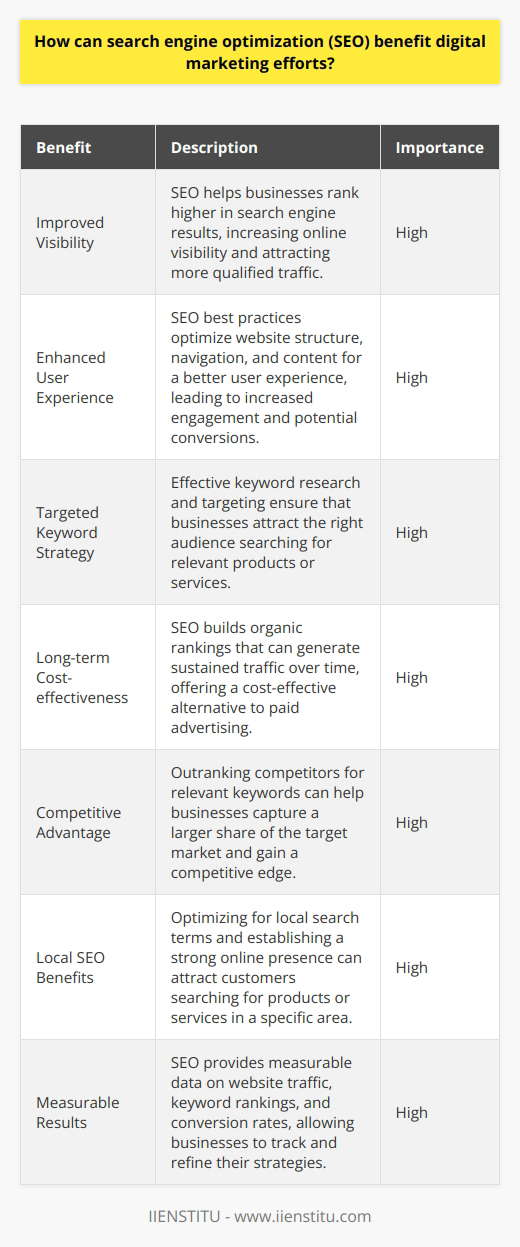
Which of the following are the 3 key channels of digital marketing: social media, email marketing, and search engine optimization
Digital marketing has become essential for businesses to reach and engage with their target audience effectively. Among the various digital marketing channels, social media, email marketing, and search engine optimization (SEO) stand out as the three key pillars. These channels have proven to be highly effective in driving brand awareness, generating leads, and ultimately converting them into customers.
Social Media Marketing
Social media platforms, such as Facebook, Instagram, Twitter, and LinkedIn, have revolutionized the way businesses interact with their customers. By creating engaging content and leveraging the power of social media advertising, companies can target specific demographics, build brand loyalty, and drive traffic to their websites. Social media also enables businesses to gather valuable insights into customer preferences and behavior, allowing them to refine their marketing strategies accordingly.
Benefits of Social Media Marketing
Increased brand visibility and awareness
Targeted advertising options
Enhanced customer engagement and interaction
Valuable insights into customer behavior
Email Marketing
Email marketing remains one of the most cost-effective and personalized ways to connect with customers. By building a database of subscribers and creating targeted email campaigns, businesses can nurture leads, promote products or services, and keep their audience informed about the latest offerings. Personalized email content based on subscriber preferences and behavior can significantly improve open rates, click-through rates, and conversion rates.
Benefits of Email Marketing
Direct and personalized communication with customers
Cost-effective compared to traditional marketing channels
Ability to segment and target specific audience groups
Measurable results and insights for optimization
Search Engine Optimization (SEO)
Search engine optimization is crucial for businesses to improve their online visibility and attract organic traffic from search engines like Google. By optimizing website content, structure, and backlinks, companies can rank higher in search engine results pages (SERPs) for relevant keywords. Higher rankings lead to increased brand credibility, more qualified website traffic, and ultimately, better conversion rates.
Benefits of Search Engine Optimization
Improved online visibility and brand credibility
Increased organic traffic from search engines
Higher quality leads and improved conversion rates
Long-term, sustainable results with proper optimization
Integrating Digital Marketing Channels
While social media, email marketing, and SEO are individually powerful, integrating these channels can create a synergistic effect and maximize their impact. For example, promoting email sign-ups on social media can help grow a subscriber base, while incorporating social sharing buttons in email campaigns can expand their reach. Similarly, optimizing website content for search engines can drive more traffic to social media profiles and email sign-up forms.
Benefits of Integrating Digital Marketing Channels
Consistent brand messaging across all channels
Increased customer engagement and loyalty
Enhanced data collection and analysis for better targeting
Maximized return on investment (ROI) for marketing efforts
In conclusion, social media, email marketing, and search engine optimization are the three key channels of digital marketing. By leveraging these channels effectively and integrating them into a cohesive strategy, businesses can achieve their marketing goals, build strong customer relationships, and drive long-term success in the digital landscape.
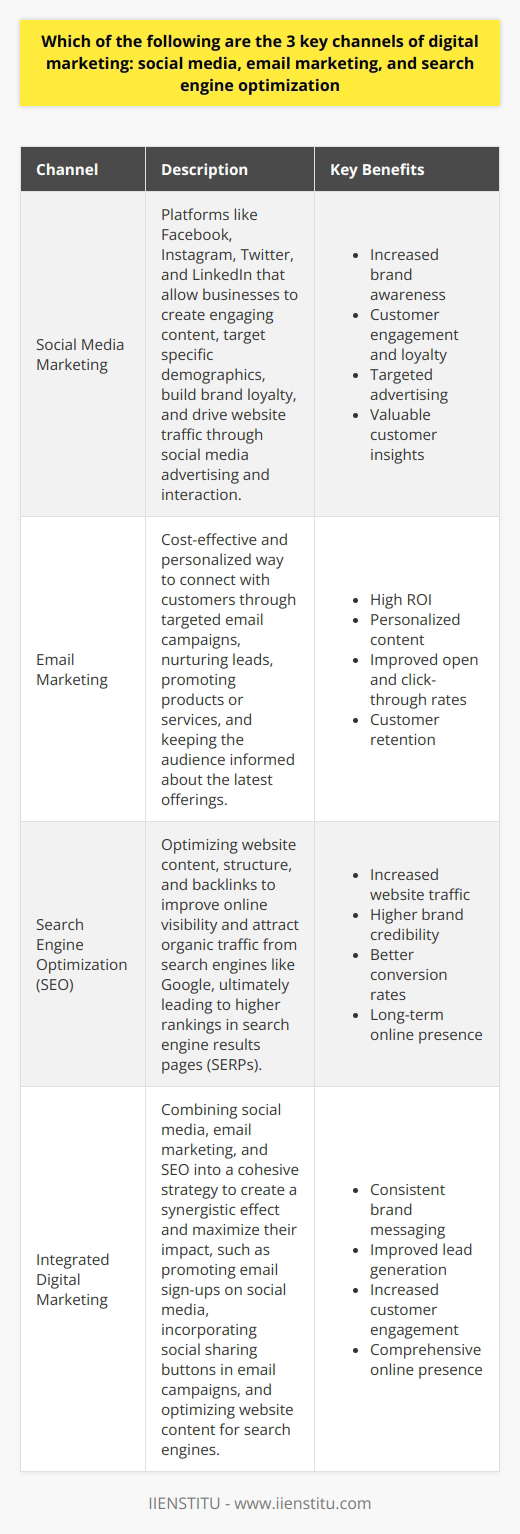
Which of the following are the 3 key channels of digital marketing: content marketing, influencer marketing, and mobile marketing
Content marketing, influencer marketing, and mobile marketing are indeed three key channels of digital marketing. Each channel offers unique opportunities to reach and engage target audiences effectively. Let's explore how these channels contribute to a comprehensive digital marketing strategy.
Content Marketing
Content marketing focuses on creating and distributing valuable, relevant, and consistent content to attract and retain a clearly defined audience. The goal is to drive profitable customer action through strategic content creation. Content marketing encompasses various formats such as blog posts, videos, infographics, and e-books.
By providing informative and engaging content, businesses can establish themselves as thought leaders in their industry. This helps build trust and credibility with potential customers, fostering long-term relationships. Additionally, high-quality content can improve search engine rankings, driving organic traffic to a company's website.
Influencer Marketing
Influencer marketing involves collaborating with individuals who have a significant following on social media platforms. These influencers have the ability to sway the opinions and purchasing decisions of their followers. By partnering with relevant influencers, brands can tap into new audiences and gain credibility through endorsements.
Influencer marketing campaigns can take various forms, such as sponsored posts, product reviews, or brand ambassadorships. The key is to find influencers who align with the brand's values and target audience. Authentic and genuine partnerships tend to yield the best results, as followers can easily spot insincerity.
Mobile Marketing
With the widespread adoption of smartphones, mobile marketing has become a crucial channel for reaching consumers. Mobile marketing encompasses various tactics designed to engage users on their mobile devices. This includes mobile-friendly websites, SMS marketing, mobile apps, and mobile advertising.
To succeed in mobile marketing, businesses must ensure that their content is optimized for mobile viewing. Responsive web design and fast loading times are essential for providing a positive user experience. Push notifications and location-based marketing can also be effective in delivering timely and relevant messages to mobile users.
Integrating Digital Marketing Channels
While content marketing, influencer marketing, and mobile marketing are distinct channels, they work best when integrated into a cohesive digital marketing strategy. For example, a company can create valuable content, promote it through influencer partnerships, and ensure it is easily accessible on mobile devices.
By leveraging the strengths of each channel and ensuring consistent messaging across platforms, businesses can maximize their reach and impact. A well-executed digital marketing strategy that combines these key channels can lead to increased brand awareness, customer engagement, and ultimately, conversions.

Which of the following are the 3 key channels of digital marketing: pay-per-click advertising, affiliate marketing, and video marketing?
Digital marketing encompasses various channels, and among them, pay-per-click advertising, affiliate marketing, and video marketing are three key components. Pay-per-click advertising involves placing ads on search engines or websites and paying a fee each time a user clicks on the ad. This method allows businesses to target specific audiences and measure the effectiveness of their advertising efforts. Affiliate marketing is a performance-based approach where affiliates promote a company's products or services and earn a commission for each sale or lead generated through their unique referral link.
The Power of Video Marketing
Video marketing has gained significant traction in recent years due to its engaging and interactive nature. Videos allow businesses to showcase their products, services, or brand personality in a dynamic and visually appealing manner. Platforms like YouTube, Instagram, and TikTok have made video content more accessible and shareable, enabling companies to reach a wider audience. Video marketing can take various forms, such as product demonstrations, tutorial videos, customer testimonials, or even live streaming events.
Benefits of Pay-Per-Click Advertising
Pay-per-click advertising offers several advantages for businesses looking to drive targeted traffic to their websites. By bidding on relevant keywords, companies can ensure that their ads appear in front of potential customers actively searching for related products or services. This targeted approach helps businesses attract qualified leads and maximize their return on investment. Additionally, pay-per-click advertising provides detailed analytics, allowing marketers to track the performance of their campaigns and make data-driven decisions to optimize their strategies.
Affiliate Marketing: A Cost-Effective Approach
Affiliate marketing is an attractive option for businesses seeking to expand their reach without incurring significant upfront costs. By partnering with affiliates who have established audiences in relevant niches, companies can tap into new markets and generate sales through trusted recommendations. Affiliates are motivated to promote products effectively since they earn commissions based on their performance. This mutually beneficial relationship allows businesses to scale their marketing efforts while maintaining a cost-effective approach.
Integrating Digital Marketing Channels
While pay-per-click advertising, affiliate marketing, and video marketing are powerful channels individually, integrating them into a comprehensive digital marketing strategy can yield even better results. For example, businesses can use pay-per-click ads to drive traffic to their video content, increasing visibility and engagement. Similarly, affiliates can incorporate videos into their promotional efforts to provide a more immersive experience for their audience. By leveraging the strengths of each channel and creating a cohesive marketing plan, businesses can maximize their online presence and achieve their desired outcomes.
Measuring Success and Adapting Strategies
To ensure the effectiveness of digital marketing efforts, it is crucial to establish clear goals and metrics. Regularly monitoring and analyzing key performance indicators such as click-through rates, conversion rates, and return on investment helps businesses gauge the success of their campaigns. Based on these insights, marketers can make data-driven decisions to refine their strategies, allocate resources effectively, and continuously improve their digital marketing initiatives.
Staying Ahead of the Curve
Digital marketing is a dynamic and ever-evolving field. As new technologies and platforms emerge, businesses must stay agile and adapt their strategies accordingly. Keeping abreast of the latest trends, best practices, and consumer preferences is essential to remain competitive in the digital landscape. By embracing innovation and experimenting with new approaches, businesses can stay ahead of the curve and capitalize on emerging opportunities in the realm of digital marketing.

How do you determine which marketing channels to target in your strategies?
Determining which marketing channels to target in your strategies requires careful consideration of several factors. First, you must identify your target audience and understand their preferences, behaviors, and media consumption habits. This knowledge will help you select the channels that are most likely to reach and engage your desired customers.
Next, evaluate the strengths and weaknesses of each marketing channel in relation to your product or service. Consider the nature of your offering and determine which channels are best suited to showcase its features and benefits. For example, visual platforms like Instagram and YouTube may be more effective for promoting fashion or beauty products, while LinkedIn may be better for B2B services.
Budgetary Constraints and ROI
Your marketing budget will also play a crucial role in channel selection. Some channels, such as television advertising, can be expensive and may not be feasible for small businesses. Evaluate the costs associated with each channel and prioritize those that offer the best return on investment (ROI) based on your available resources.
Competitor Analysis
Analyzing your competitors' marketing strategies can provide valuable insights into which channels are effective in your industry. Identify the channels they are using and assess their level of success. This information can help you make informed decisions about which channels to pursue and how to differentiate your approach.
Multichannel Marketing
Consider adopting a multichannel marketing approach to maximize your reach and impact. By leveraging a combination of channels, you can engage with your audience at multiple touchpoints and reinforce your message. However, ensure that your chosen channels work together seamlessly and provide a consistent brand experience.
Testing and Optimization
Once you have selected your target channels, continuously monitor their performance and adjust your strategy as needed. Conduct regular tests and experiments to optimize your campaigns and allocate your resources towards the channels that generate the best results. Remember that marketing is an iterative process, and what works today may not be as effective tomorrow.
Staying Up-to-Date
Stay informed about emerging marketing channels and trends. The digital landscape is constantly evolving, and new platforms and technologies are regularly introduced. Be open to exploring new channels that align with your target audience and marketing goals, but always assess their potential before investing significant resources.
Seek Expert Guidance
If you are unsure about which marketing channels to target, consider seeking guidance from marketing professionals or agencies. They can provide valuable insights based on their experience and expertise, helping you make informed decisions and avoid costly mistakes.
In conclusion, selecting the right marketing channels requires a strategic approach that considers your target audience, product or service, budget, competitors, and industry trends. By carefully evaluating these factors and continuously optimizing your efforts, you can develop an effective marketing strategy that drives results and helps you achieve your business goals.
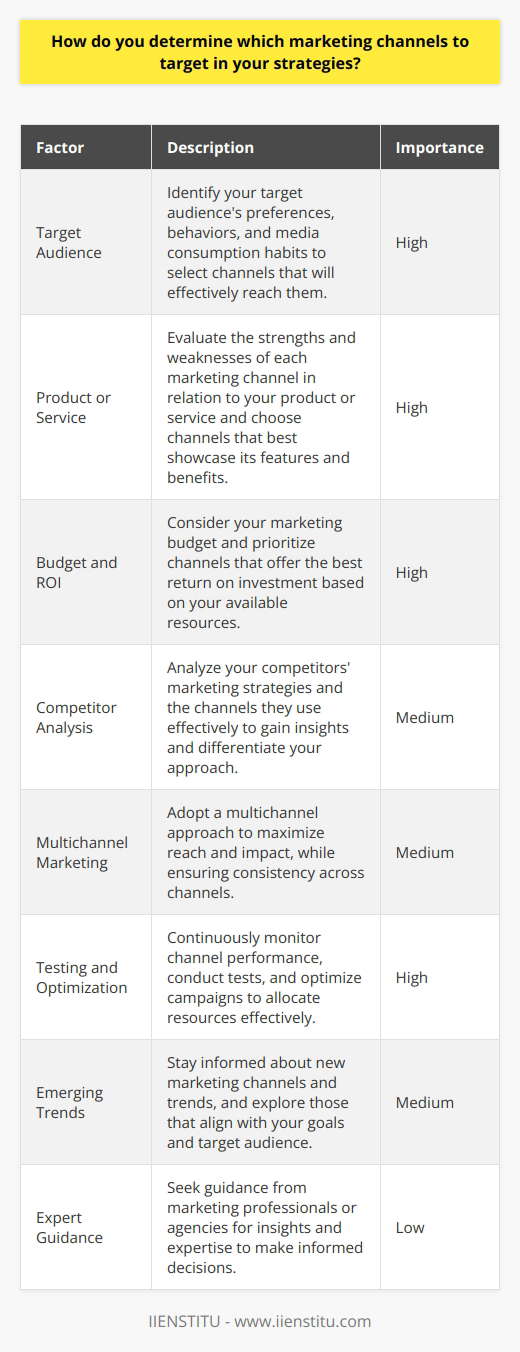
What factors should be considered when selecting marketing channels for a campaign?
Selecting marketing channels for a campaign requires careful consideration of several key factors. Marketers must evaluate the target audience, budget constraints, and desired outcomes to make informed decisions. The chosen channels should align with the preferences and behaviors of the intended audience. For instance, younger demographics may be more responsive to social media campaigns, while older generations might prefer traditional media. Budget limitations also play a crucial role in channel selection, as some channels may be more cost-effective than others. The marketing team should assess the potential return on investment for each channel. Additionally, the campaign's objectives, such as brand awareness, lead generation, or sales, will influence the choice of channels.
Understanding the Target Audience
To select the most effective marketing channels, marketers must have a deep understanding of their target audience. Conducting market research and analyzing customer data can provide valuable insights into the audience's demographics, psychographics, and behavioral patterns. This information helps identify the channels that the target audience frequently uses and engages with. For example, if the campaign targets tech-savvy millennials, digital channels like social media, email marketing, and mobile advertising may be more appropriate. On the other hand, if the audience consists of senior citizens, traditional channels such as print media, radio, and television might be more effective.
Aligning Channels with Campaign Objectives
The marketing team should clearly define the campaign's objectives before selecting the channels. Different objectives may require different approaches and channels. For instance, if the primary goal is to increase brand awareness, channels with a wide reach, such as television, radio, and social media, may be suitable. If the objective is to generate leads or drive sales, channels that allow for targeted messaging and direct response, such as email marketing, search engine marketing, and content marketing, may be more effective. Aligning the chosen channels with the campaign's objectives ensures that the marketing efforts are focused and more likely to yield the desired results.
Considering Budget Constraints
Budget constraints are a significant factor in selecting marketing channels. Some channels, such as television advertising, can be expensive, while others, like social media marketing, may be more cost-effective. Marketers should allocate the available budget wisely, considering the potential return on investment for each channel. It may be beneficial to use a mix of channels to maximize reach and impact while staying within budget limits. Testing and monitoring the performance of each channel can help optimize the budget allocation over time.
Evaluating Channel Integration and Consistency
When selecting multiple channels for a campaign, it is crucial to ensure that they integrate seamlessly and deliver a consistent message. A cohesive campaign across different channels reinforces the brand's message and enhances the overall impact. Marketers should consider how the chosen channels can complement each other and create a unified experience for the audience. For example, a social media campaign can drive traffic to a landing page, which can then encourage email sign-ups or purchases. Consistency in messaging, visuals, and tone across all channels helps build brand recognition and trust.
Monitoring and Adapting
Marketing channel selection is not a one-time decision. Marketers should continuously monitor the performance of the selected channels and adapt the strategy as needed. Regular analysis of metrics such as reach, engagement, conversion rates, and return on investment helps identify the channels that are delivering the best results. Based on these insights, marketers can make data-driven decisions to optimize the channel mix, allocate resources more effectively, and improve the overall campaign performance.
In conclusion, selecting marketing channels for a campaign involves careful consideration of the target audience, campaign objectives, budget constraints, channel integration, and ongoing monitoring. By understanding the audience, aligning channels with objectives, allocating resources wisely, ensuring consistency, and adapting based on performance, marketers can create effective campaigns that deliver the desired results.
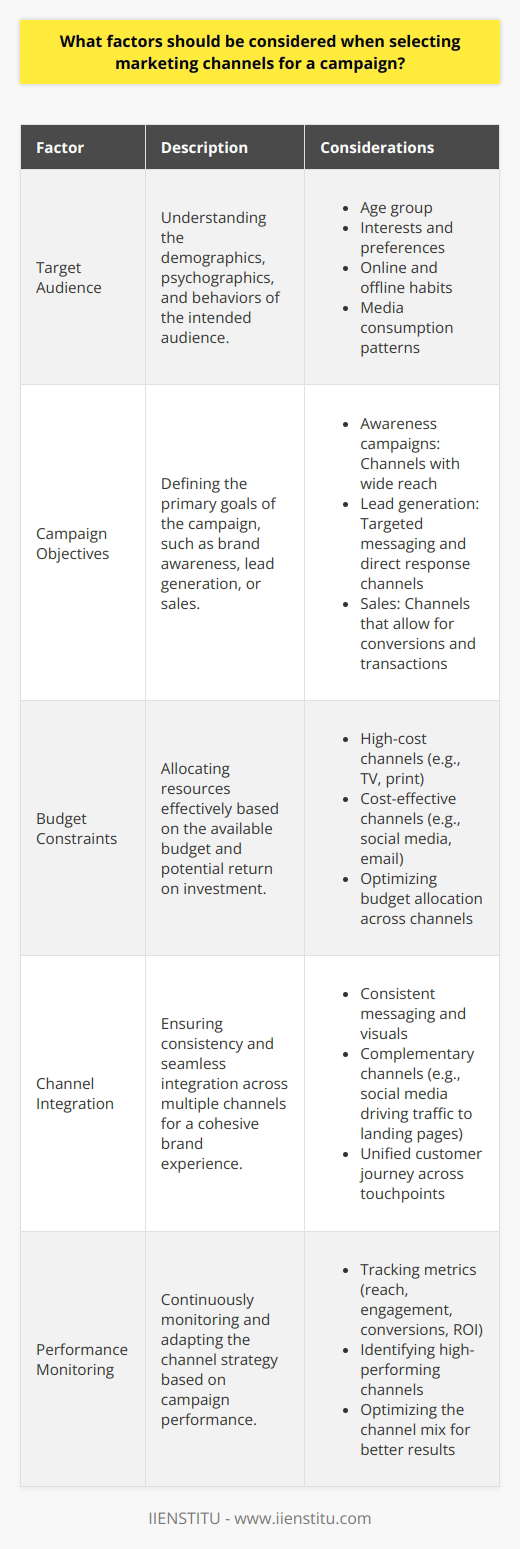
How can a company effectively allocate its marketing budget across different channels?
Effectively allocating a marketing budget across different channels is crucial for a company's success. It requires careful consideration of various factors, such as target audience, marketing goals, and channel performance. To make informed decisions, companies should conduct thorough research and analyze data from previous campaigns. This data can provide valuable insights into which channels yield the best return on investment (ROI) and engage the target audience most effectively.
Set Clear Marketing Goals
Before allocating the marketing budget, companies must define their marketing goals. These goals should align with the overall business objectives and be specific, measurable, achievable, relevant, and time-bound (SMART). Clear goals help prioritize channels and determine the appropriate budget allocation for each.
Understand Your Target Audience
Knowing your target audience is essential for selecting the most effective marketing channels. Different audiences have different preferences and behaviors when it comes to consuming content and engaging with brands. By understanding your audience's demographics, interests, and online habits, you can identify the channels that are most likely to reach and resonate with them.
Conduct Market Research
Market research helps companies gather valuable information about their target audience and competitors. It can involve surveys, focus groups, and analyzing industry trends. This research provides insights into the most effective channels for reaching the target audience and helps identify opportunities for differentiation from competitors.
Analyze Historical Data
Analyzing data from previous marketing campaigns is crucial for making informed budget allocation decisions. This data can reveal which channels have performed well in the past, driving the most engagement, conversions, and ROI. By identifying patterns and trends, companies can optimize their budget allocation and focus on the channels that have proven to be most effective.
Track Key Performance Indicators (KPIs)
Monitoring KPIs is essential for measuring the success of marketing efforts across different channels. KPIs can include metrics such as website traffic, lead generation, conversion rates, and customer acquisition costs. By regularly tracking and analyzing these KPIs, companies can identify which channels are performing well and adjust their budget allocation accordingly.
Consider the Marketing Funnel
The marketing funnel represents the customer journey from awareness to conversion. Different marketing channels play distinct roles at each stage of the funnel. For example, social media and content marketing may be more effective for building brand awareness, while email marketing and retargeting ads may be better suited for nurturing leads and driving conversions. Companies should allocate their budget based on the specific goals and objectives of each stage of the funnel.
Allocate Budget Based on Channel Roles
Each marketing channel serves a unique purpose and has its strengths and weaknesses. Search engine optimization (SEO) and pay-per-click (PPC) advertising, for instance, are effective for driving website traffic and generating leads. Social media, on the other hand, is valuable for building brand awareness and engaging with the audience. By understanding the roles and capabilities of each channel, companies can allocate their budget in a way that maximizes the impact of their marketing efforts.
Test and Optimize
Marketing budget allocation is not a one-time decision. It requires continuous testing, monitoring, and optimization. Companies should regularly assess the performance of each channel and make data-driven adjustments to their budget allocation. A/B testing can help identify the most effective ad copy, targeting options, and landing pages for each channel. By continuously refining and optimizing their approach, companies can maximize the ROI of their marketing budget.
Embrace Flexibility
The marketing landscape is constantly evolving, with new channels and technologies emerging regularly. Companies should maintain a flexible approach to budget allocation, allowing for adjustments based on changing market conditions, audience preferences, and emerging opportunities. By staying agile and adaptable, companies can quickly respond to changes and allocate their budget in a way that maximizes their marketing impact.
In conclusion, effectively allocating a marketing budget across different channels requires a strategic and data-driven approach. By setting clear goals, understanding the target audience, analyzing historical data, considering the marketing funnel, and embracing flexibility, companies can optimize their budget allocation and achieve better marketing results.

What is channel mix in digital marketing?
Channel mix in digital marketing refers to the combination of digital channels used to reach and engage target audiences. It involves selecting the most effective channels to deliver marketing messages and achieve business objectives. The choice of channels depends on factors such as target audience preferences, budget, and marketing goals.
Types of Digital Marketing Channels
Digital marketing encompasses a wide range of channels, each with its unique characteristics and benefits. Some of the most common digital marketing channels include:
1. Search Engine Marketing (SEM)
SEM involves paid advertising on search engines like Google or Bing to increase website visibility and drive traffic. It includes strategies such as pay-per-click (PPC) advertising and search engine optimization (SEO).
2. Social Media Marketing
Social media platforms like Facebook, Instagram, and Twitter allow businesses to connect with their target audience. Marketers can use organic content or paid advertising to engage with users and promote their products or services.
3. Email Marketing
Email marketing involves sending promotional or informational messages to a list of subscribers. It can be used to nurture leads, promote products, or keep customers engaged.
4. Content Marketing
Content marketing focuses on creating and distributing valuable, relevant, and consistent content to attract and retain a target audience. It can include blog posts, videos, infographics, and more.
Importance of Channel Mix
Developing an effective channel mix is crucial for the success of a digital marketing campaign. It allows marketers to:
1. Reach the Right Audience
Different channels appeal to different demographics and user behaviors. By selecting the right mix of channels, marketers can reach their target audience more effectively.
2. Maximize ROI
Allocating resources to the most effective channels can help maximize return on investment (ROI). Marketers can analyze data and adjust their channel mix accordingly.
3. Improve Brand Awareness
Using multiple channels can increase brand visibility and reach. It allows marketers to engage with audiences across different touchpoints and build brand awareness.
Developing a Channel Mix Strategy
To develop an effective channel mix strategy, marketers should:
1. Define Marketing Goals
Clearly define the objectives of the digital marketing campaign, whether it's to increase website traffic, generate leads, or drive sales.
2. Identify Target Audience
Understand the demographics, interests, and behaviors of the target audience to select the most appropriate channels.
3. Evaluate Channel Performance
Analyze data and metrics to evaluate the performance of each channel and make data-driven decisions to optimize the channel mix.
4. Test and Refine
Continuously test and refine the channel mix based on performance data to ensure the most effective allocation of resources.
In conclusion, developing an effective channel mix is essential for the success of a digital marketing campaign. By selecting the right combination of channels and continuously optimizing based on data, marketers can reach their target audience, maximize ROI, and achieve their business objectives.

How does channel mix contribute to a successful digital marketing strategy?
Channel mix plays a crucial role in the success of a digital marketing strategy. It involves selecting and combining various digital channels to reach and engage the target audience effectively. By carefully choosing the right mix of channels, marketers can maximize their reach, deliver targeted messages, and achieve their marketing goals.
Maximizing Reach and Engagement
A well-designed channel mix helps marketers reach their target audience where they are most active and responsive. Different channels, such as social media, email, search engines, and websites, have distinct user demographics and behaviors. By understanding these characteristics, marketers can allocate their resources and efforts to the channels that align with their target audience's preferences.
Moreover, using multiple channels in a coordinated manner amplifies the impact of the marketing message. Consistent messaging across channels reinforces brand recognition and recall. It also provides multiple touchpoints for the audience to interact with the brand, increasing the likelihood of engagement and conversion.
Tailoring Content to Each Channel
Each digital channel has its own best practices and audience expectations. A successful channel mix strategy adapts the content and format to suit the specific channel. For example, visually appealing images and short videos work well on social media, while informative blog posts and detailed product descriptions are suitable for websites.
By tailoring the content to each channel, marketers can deliver a more engaging and relevant experience to their audience. This approach helps build trust, establishes thought leadership, and encourages audience interaction. Ultimately, it leads to higher engagement rates and better marketing outcomes.
Enabling Data-Driven Optimization
A diverse channel mix provides a wealth of data and insights into audience behavior and preferences. Marketers can track metrics such as reach, engagement, click-through rates, and conversions across different channels. By analyzing this data, they can identify the channels that are performing well and those that need improvement.
Continuous Refinement and Adaptation
Data-driven insights enable marketers to continuously refine their channel mix and optimize their strategies. They can allocate more resources to the channels that are delivering the best results and experiment with new channels to expand their reach. This iterative approach ensures that the channel mix remains effective and relevant over time.
Staying Ahead of the Curve
The digital landscape is constantly evolving, with new channels and platforms emerging regularly. A successful channel mix strategy requires staying up-to-date with the latest trends and technologies. Marketers should be proactive in exploring and testing new channels that align with their target audience's behavior and preferences.
By being adaptable and open to new opportunities, marketers can stay ahead of the competition and maintain a competitive edge. They can leverage emerging channels to reach untapped audiences, deliver innovative experiences, and drive business growth.
In conclusion, channel mix is a vital component of a successful digital marketing strategy. It enables marketers to maximize reach, engage their target audience effectively, and achieve their marketing goals. By carefully selecting and combining digital channels, tailoring content to each channel, and leveraging data-driven insights, marketers can create a powerful and resilient channel mix that drives long-term success.
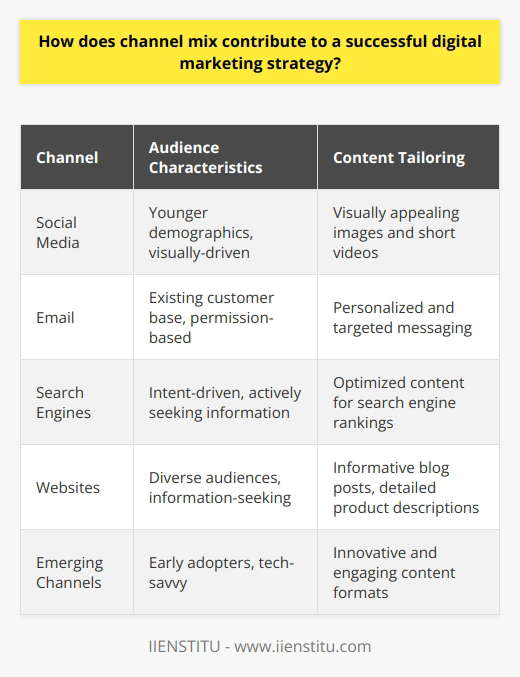
What factors should be considered when determining the optimal channel mix for a digital marketing campaign?
Determining the optimal channel mix for a digital marketing campaign requires careful consideration of several key factors. These factors include the target audience, marketing objectives, budget, and the strengths and weaknesses of each channel. By thoroughly analyzing these elements, marketers can develop an effective channel strategy that maximizes reach, engagement, and conversions.
Understanding the Target Audience
The first step in determining the optimal channel mix is to gain a deep understanding of the target audience. This involves researching their demographics, psychographics, behaviors, and preferences. Marketers should identify which channels the target audience uses most frequently and how they engage with content on those platforms. This information will help guide the selection of channels that are most likely to reach and resonate with the intended audience.
Defining Marketing Objectives
Clearly defining the marketing objectives is crucial for selecting the appropriate channels. Different objectives may require different channel strategies. For example, if the primary goal is to increase brand awareness, channels with broad reach, such as social media and display advertising, may be prioritized. On the other hand, if the objective is to drive direct sales, channels with strong conversion rates, like search engine marketing and email marketing, may be more effective.
Allocating Budget Effectively
The available budget is another critical factor in determining the optimal channel mix. Some channels, such as television advertising, can be expensive and may not be feasible for small businesses or startups. Marketers should allocate the budget based on the expected return on investment (ROI) of each channel. This requires careful analysis of historical data and industry benchmarks to estimate the potential performance of each channel.
Evaluating Channel Strengths and Weaknesses
Each digital marketing channel has its own strengths and weaknesses. Marketers should evaluate these characteristics to determine which channels are best suited for their specific campaign. For instance, social media platforms offer precise targeting options and the ability to engage with the audience directly. However, organic reach on social media can be limited, and paid advertising may be necessary to achieve significant results. Email marketing, on the other hand, allows for personalized communication with a highly engaged audience but requires a quality email list and effective copywriting skills.
Measuring and Optimizing Performance
Once the initial channel mix is determined, it is essential to continuously monitor and measure the performance of each channel. This involves tracking key metrics such as reach, engagement, click-through rates, and conversions. By regularly analyzing this data, marketers can identify which channels are delivering the best results and adjust the channel mix accordingly. Optimization may involve reallocating budget to high-performing channels, refining targeting options, or experimenting with new channels to improve overall campaign performance.
Conclusion
Determining the optimal channel mix for a digital marketing campaign is a complex process that requires careful consideration of multiple factors. By understanding the target audience, defining clear objectives, allocating budget effectively, and evaluating channel strengths and weaknesses, marketers can develop a channel strategy that maximizes the impact of their campaigns. Continuous measurement and optimization are essential to ensure that the channel mix remains effective over time and adapts to changing market conditions and consumer behaviors.
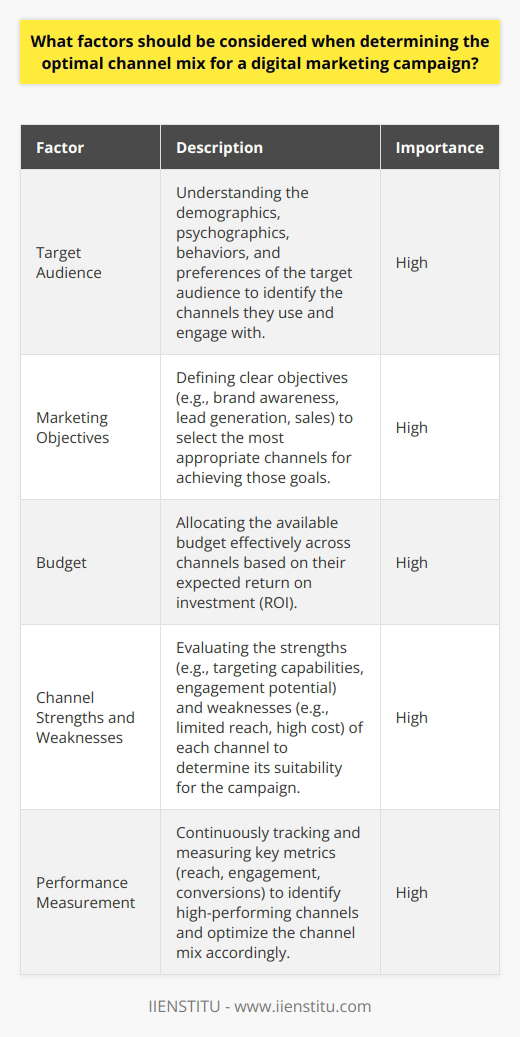
What are some channels of digital marketing?
Digital marketing encompasses various channels that businesses utilize to reach and engage with their target audience online. These channels include search engine optimization (SEO), pay-per-click (PPC) advertising, social media marketing, email marketing, content marketing, and affiliate marketing. Each channel offers unique opportunities to connect with potential customers and promote products or services.
Search Engine Optimization (SEO)
SEO involves optimizing a website's content and structure to improve its visibility in search engine results pages (SERPs). By targeting relevant keywords and providing high-quality, informative content, businesses can attract organic traffic to their websites. SEO also includes building high-quality backlinks from other reputable websites to establish authority and credibility.
Pay-Per-Click (PPC) Advertising
PPC advertising allows businesses to display ads on search engine results pages and other websites. Advertisers pay a fee each time a user clicks on their ad, hence the name "pay-per-click." Google Ads and Microsoft Ads are popular platforms for PPC advertising, enabling businesses to target specific keywords, demographics, and locations.
Social Media Marketing
Social media platforms like Facebook, Instagram, Twitter, and LinkedIn provide opportunities to engage with target audiences. Businesses can create profiles, share content, and interact with followers to build brand awareness and loyalty. Paid social media advertising options allow for targeted campaigns based on user demographics, interests, and behaviors.
Email Marketing
Email marketing involves sending promotional or informational messages directly to subscribers' email inboxes. This channel allows businesses to nurture leads, promote products or services, and keep customers engaged. Email marketing can be automated and personalized based on subscriber preferences and behaviors, making it a cost-effective way to reach a large audience.
Content Marketing
Content marketing focuses on creating and distributing valuable, relevant, and consistent content to attract and retain a clearly defined audience. This can include blog posts, videos, infographics, e-books, and more. By providing informative and engaging content, businesses can establish themselves as thought leaders in their industry and build trust with potential customers.
Affiliate Marketing
Affiliate marketing involves partnering with other businesses or individuals to promote products or services. Affiliates earn a commission for each sale or lead generated through their unique referral link. This channel can be an effective way to expand reach and drive sales without incurring upfront advertising costs.
By leveraging these digital marketing channels, businesses can reach and engage with their target audience more effectively. A well-rounded digital marketing strategy should incorporate a mix of these channels based on the business's goals, budget, and target audience preferences.

What are the most effective digital marketing channels for small businesses?
Digital marketing channels offer small businesses a cost-effective way to reach their target audience and grow their brand. The most effective digital marketing channels for small businesses include social media, email marketing, content marketing, and search engine optimization (SEO). Each channel has its own strengths and weaknesses, and the best approach depends on the specific goals and resources of the business.
Social Media Marketing
Social media platforms like Facebook, Instagram, and Twitter provide small businesses with a direct line of communication to their customers. By creating engaging content and interacting with followers, small businesses can build brand awareness and loyalty. Social media also allows for targeted advertising, which can be highly effective in reaching specific demographics.
Tips for Social Media Marketing
Choose the right platforms for your target audience
Post regularly and consistently
Engage with your followers by responding to comments and messages
Use visuals like images and videos to grab attention
Take advantage of paid advertising options for targeted reach
Email Marketing
Email marketing is another powerful tool for small businesses. By collecting email addresses from customers and prospects, businesses can send targeted messages and promotions directly to their inbox. Email marketing can be used to nurture leads, promote products and services, and keep customers engaged with the brand.
Tips for Email Marketing
Build your email list through opt-in forms on your website and social media
Segment your list based on interests and behaviors for targeted messaging
Use a clear and compelling subject line to increase open rates
Keep your emails short and to the point
Include a clear call-to-action (CTA) to encourage engagement
Content Marketing
Content marketing involves creating and sharing valuable, relevant, and consistent content to attract and retain a clearly defined audience. By providing helpful information and resources, small businesses can establish themselves as thought leaders in their industry and build trust with their target audience.
Tips for Content Marketing
Identify your target audience and their pain points
Create content that addresses those pain points and provides value
Use a variety of formats like blog posts, videos, infographics, and podcasts
Optimize your content for search engines to increase visibility
Promote your content through social media and email marketing
Search Engine Optimization (SEO)
SEO involves optimizing your website and content to rank higher in search engine results pages (SERPs). By improving your search engine rankings, small businesses can increase their visibility and attract more organic traffic to their website.
Tips for SEO
Conduct keyword research to identify relevant keywords for your business
Optimize your website's title tags, meta descriptions, and header tags
Create high-quality, keyword-rich content that provides value to your audience
Build high-quality backlinks from relevant websites
Use local SEO tactics to improve visibility in local search results
Conclusion
Digital marketing offers a wealth of opportunities for small businesses to reach and engage with their target audience. By leveraging social media, email marketing, content marketing, and SEO, small businesses can build brand awareness, generate leads, and drive sales. The key is to identify the channels that are most effective for your specific business and audience, and to develop a strategic plan for success.

How do different digital marketing channels complement each other in a comprehensive marketing strategy?
Digital marketing channels work together to create a cohesive and effective marketing strategy. Each channel has its strengths and weaknesses, but when used in combination, they can amplify each other's effects. For example, social media can be used to build brand awareness and engage with customers, while email marketing can be used to nurture leads and drive conversions. Paid advertising, such as Google AdWords or Facebook Ads, can be used to target specific audiences and drive traffic to a website or landing page.
Content Marketing and SEO
Content marketing and SEO are two essential components of a comprehensive digital marketing strategy. Content marketing involves creating valuable and relevant content that attracts and engages target audiences. This content can be in the form of blog posts, videos, infographics, or social media posts. SEO, on the other hand, involves optimizing website content and structure to rank higher in search engine results pages (SERPs). By creating high-quality content that is optimized for search engines, businesses can attract more organic traffic to their website.
Social Media Marketing
Social media marketing is another important channel that complements other digital marketing efforts. Social media platforms like Facebook, Twitter, and Instagram allow businesses to connect with their target audience and build brand awareness. By regularly posting engaging content and interacting with followers, businesses can build a loyal following and drive traffic to their website. Social media can also be used to run targeted ads and promote special offers or events.
Email Marketing
Email marketing is a highly effective way to nurture leads and drive conversions. By sending targeted and personalized emails to subscribers, businesses can build relationships with their audience and encourage them to take action. Email marketing can be used to promote new products or services, offer exclusive discounts, or provide valuable content. When used in conjunction with other channels, such as social media and content marketing, email marketing can be a powerful tool for driving sales and revenue.
Paid Advertising
Paid advertising, such as Google AdWords or Facebook Ads, can be used to complement other digital marketing efforts. Paid ads allow businesses to target specific audiences based on demographics, interests, and behaviors. By creating compelling ad copy and visuals, businesses can attract clicks and drive traffic to their website or landing page. Paid advertising can be especially effective for promoting time-sensitive offers or events, or for targeting audiences that may not be reached through other channels.
Analytics and Optimization
Finally, analytics and optimization are crucial for ensuring that digital marketing efforts are effective and efficient. By tracking key metrics such as website traffic, conversion rates, and engagement rates, businesses can identify areas for improvement and optimize their strategies accordingly. A/B testing can be used to test different variations of ad copy, landing pages, or email subject lines to determine which versions perform best. By continuously monitoring and optimizing their digital marketing efforts, businesses can maximize their ROI and achieve their marketing goals.
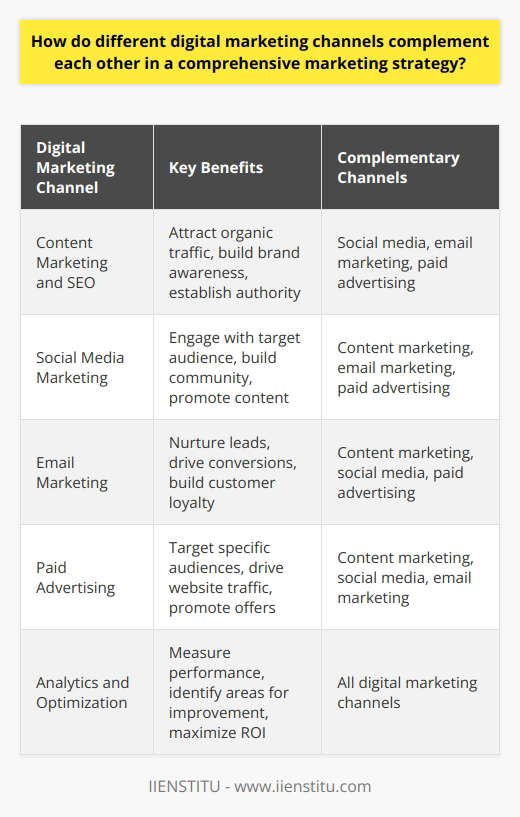
Which of the following are the 3 key channels of digital marketing: email marketing, social media marketing, and search engine marketing?
Digital marketing has become an essential component of modern business strategies, enabling companies to reach and engage with their target audiences effectively. Among the various digital marketing channels available, three key channels stand out: email marketing, social media marketing, and search engine marketing. These channels have proven to be highly effective in driving brand awareness, generating leads, and ultimately converting prospects into customers.
Email Marketing
Email marketing is a powerful tool that allows businesses to communicate directly with their subscribers. By sending targeted, personalized messages to a list of opt-in subscribers, companies can nurture relationships, promote products or services, and encourage customer loyalty. Email marketing campaigns can be automated, ensuring that the right message reaches the right person at the right time.
To maximize the effectiveness of email marketing, it is crucial to segment your email list based on subscriber preferences, behavior, and demographics. This segmentation enables you to deliver highly relevant content that resonates with each group, increasing the likelihood of engagement and conversion. Additionally, optimizing your email design, subject lines, and call-to-actions can significantly improve open rates and click-through rates.
Social Media Marketing
Social media platforms have revolutionized the way businesses interact with their customers. With billions of active users across various platforms, social media marketing provides an unparalleled opportunity to reach a vast audience. By creating engaging content, running targeted ad campaigns, and fostering community interaction, companies can build brand awareness, generate leads, and drive sales.
To succeed in social media marketing, it is essential to identify the platforms where your target audience is most active. Whether it's Facebook, Instagram, Twitter, LinkedIn, or others, each platform has its unique characteristics and requires a tailored approach. Consistently publishing valuable content, engaging with your followers, and leveraging influencer partnerships can help you establish a strong social media presence and achieve your marketing goals.
Search Engine Marketing
Search engine marketing (SEM) focuses on increasing a website's visibility and driving traffic through paid advertising on search engines like Google or Bing. SEM involves placing ads on search engine results pages (SERPs) based on specific keywords relevant to your business. When users search for those keywords, your ads have the opportunity to appear at the top of the search results, increasing the likelihood of clicks and conversions.
To optimize your SEM campaigns, conduct thorough keyword research to identify the terms your target audience is using when searching for products or services like yours. Create compelling ad copy that highlights your unique value proposition and includes a clear call-to-action. Additionally, consider implementing landing pages specifically designed for your SEM campaigns to provide a seamless user experience and increase conversion rates.
Conclusion
Email marketing, social media marketing, and search engine marketing are indeed three key channels of digital marketing. By leveraging these channels strategically, businesses can effectively reach and engage their target audiences, drive website traffic, generate leads, and ultimately boost sales. However, it is important to remember that a comprehensive digital marketing strategy should integrate multiple channels and tactics to maximize results and achieve long-term success.

Which of the following are the 3 key channels of digital marketing: content marketing, affiliate marketing, and mobile marketing?
Content marketing, affiliate marketing, and mobile marketing are indeed three key channels of digital marketing. Each channel offers unique opportunities to reach and engage target audiences effectively. Let's explore each of these channels in more detail.
Content Marketing
Content marketing involves creating and distributing valuable, relevant, and consistent content to attract and retain a clearly defined audience. The ultimate goal is to drive profitable customer action. Content can take many forms, such as blog posts, videos, podcasts, infographics, and more.
By providing informative and engaging content, businesses can establish themselves as thought leaders in their industry. This helps build trust and credibility with potential customers. Additionally, content marketing supports SEO efforts by providing opportunities to target relevant keywords and earn valuable backlinks.
Affiliate Marketing
Affiliate marketing is a performance-based marketing channel where businesses reward affiliates for each customer brought in through their unique referral link. Affiliates can be bloggers, influencers, or even other businesses that promote products or services to their audience.
This channel allows businesses to expand their reach by leveraging the audiences of their affiliates. It also provides a cost-effective way to drive sales, as affiliates are only paid when they generate a desired action, such as a sale or lead.
Benefits of Affiliate Marketing
Expand reach to new audiences
Cost-effective, performance-based pricing model
Benefit from the trust and credibility of affiliates
Mobile Marketing
With the widespread adoption of smartphones and tablets, mobile marketing has become a crucial channel for reaching customers. Mobile marketing encompasses various tactics, such as SMS marketing, mobile apps, mobile-optimized websites, and mobile advertising.
By targeting customers on their mobile devices, businesses can deliver personalized, time-sensitive, and location-based messages. This allows for more targeted and effective marketing campaigns. Additionally, mobile marketing provides opportunities for interactive engagement, such as through mobile apps or QR codes.
Mobile Marketing Tactics
SMS marketing
Mobile apps
Mobile-optimized websites
Mobile advertising
Integrating Digital Marketing Channels
While content marketing, affiliate marketing, and mobile marketing are distinct channels, they work best when integrated into a comprehensive digital marketing strategy. By leveraging the strengths of each channel and ensuring consistent messaging across all touchpoints, businesses can maximize their impact and drive better results.
For example, a business could create valuable content to attract and engage potential customers, use affiliate marketing to expand their reach, and then deliver targeted mobile messages to drive conversions. By using data and insights gathered from each channel, businesses can continually refine their strategies and optimize their performance over time.
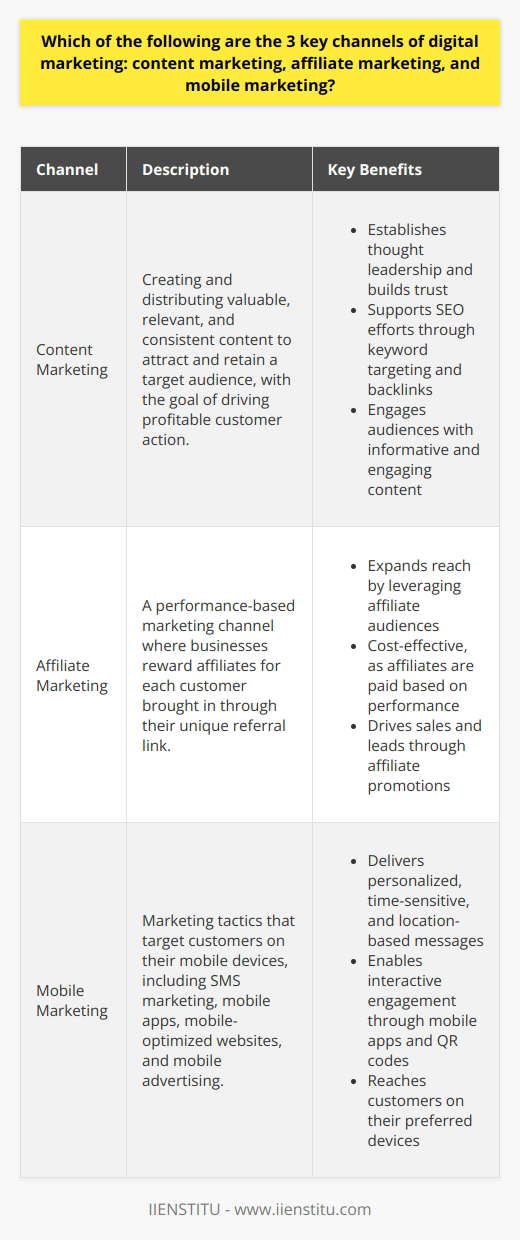
Which of the following are the 3 key channels of digital marketing: display advertising, video marketing, and influencer marketing?
Display advertising, video marketing, and influencer marketing are indeed three key channels of digital marketing. These channels have proven to be effective in reaching and engaging target audiences in the digital landscape. Each channel offers unique advantages and can be leveraged to achieve specific marketing objectives.
Display Advertising
Display advertising involves placing visual advertisements on websites, apps, and social media platforms. These ads can be in the form of banners, images, or text and are designed to attract attention and drive traffic to a website or landing page. Display ads can be targeted to specific audiences based on demographics, interests, and behaviors, making them an effective way to reach potential customers.
Advantages of Display Advertising
Increases brand awareness and visibility
Drives traffic to websites and landing pages
Allows for precise targeting of specific audiences
Can be cost-effective compared to traditional advertising methods
Video Marketing
Video marketing involves creating and distributing video content to engage and inform target audiences. Videos can be used to showcase products, provide educational content, or tell brand stories. Video content is highly engaging and can be easily shared across multiple platforms, making it an effective way to reach and connect with audiences.
Advantages of Video Marketing
Increases engagement and time spent on websites
Improves brand awareness and recall
Can be used to educate and inform audiences
Allows for creative storytelling and emotional connection
Influencer Marketing
Influencer marketing involves partnering with individuals who have a significant following on social media platforms to promote products or services. Influencers can be celebrities, industry experts, or micro-influencers with a highly engaged niche audience. By leveraging the credibility and reach of influencers, brands can effectively target and engage specific audiences.
Advantages of Influencer Marketing
Increases brand credibility and trust
Allows for targeted audience reach
Can lead to increased engagement and conversions
Provides opportunities for creative content collaboration
Integrating Digital Marketing Channels
While display advertising, video marketing, and influencer marketing are three key channels of digital marketing, they are not the only ones. Other important channels include email marketing, content marketing, and search engine optimization (SEO). To achieve the best results, it is important to develop an integrated digital marketing strategy that leverages multiple channels to reach and engage target audiences effectively.
Developing an Integrated Digital Marketing Strategy
An integrated digital marketing strategy should consider the unique strengths and advantages of each channel and how they can work together to achieve marketing objectives. This may involve using display advertising to drive traffic to a website, video marketing to educate and engage audiences, and influencer marketing to build brand credibility and reach new audiences. By leveraging multiple channels and developing a cohesive strategy, brands can effectively reach and engage their target audiences in the digital landscape.
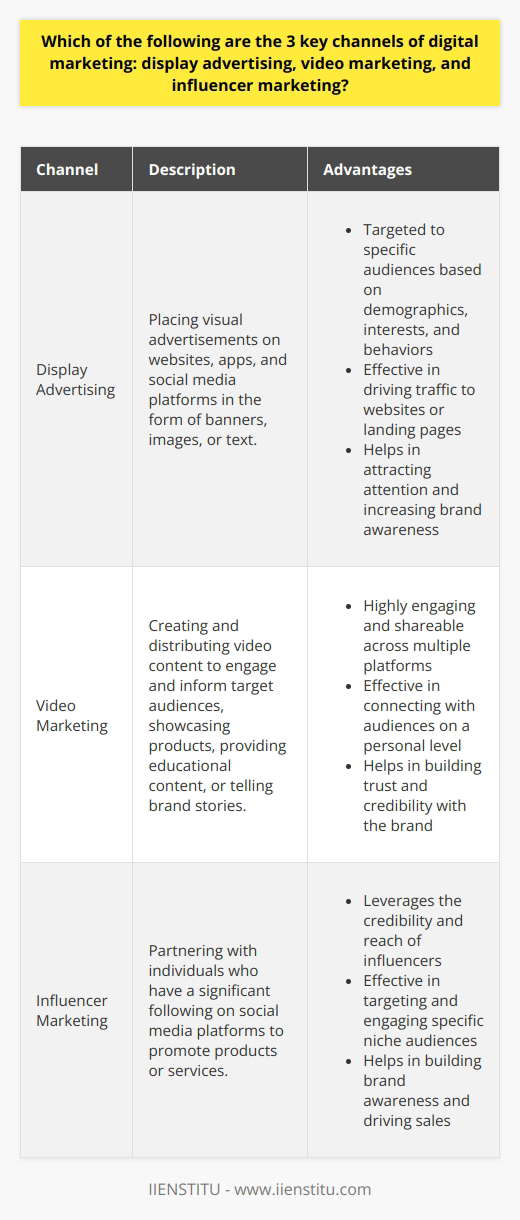
How do you determine which marketing channels to target in your strategies?
Determining which marketing channels to target in your strategies requires careful consideration of several factors. First, you must identify your target audience and understand their preferences, behaviors, and media consumption habits. This information will guide you towards the channels that are most likely to reach and engage your desired customers.
Next, evaluate the strengths and limitations of each marketing channel in relation to your product or service. Some channels may be more effective for building brand awareness, while others may be better suited for driving conversions or fostering customer loyalty. Consider the nature of your offering and the stage of the customer journey you are targeting.
Assess Your Budget and Resources
It is crucial to assess your available budget and resources when selecting marketing channels. Some channels, such as television advertising or large-scale events, may require substantial investments. Other channels, like social media or email marketing, can be more cost-effective but may demand significant time and effort to manage effectively.
Analyze Your Competition
Analyzing your competition can provide valuable insights into which marketing channels are working well in your industry. Identify the channels your competitors are using and assess their level of success. Look for gaps or opportunities they may have overlooked, and consider how you can differentiate your approach to gain a competitive advantage.
Test and Measure Performance
Implementing a multi-channel marketing strategy allows you to test and measure the performance of different channels. Start with a mix of channels that align with your target audience and goals, and continuously monitor their effectiveness. Use metrics such as reach, engagement, conversions, and ROI to evaluate each channel's performance and make data-driven decisions to optimize your strategy over time.
Adapt to Changing Trends and Technologies
The digital landscape is constantly evolving, with new marketing channels and technologies emerging regularly. Stay informed about the latest trends and be open to experimenting with new channels that may resonate with your target audience. Continuously adapt your strategy to stay relevant and effectively reach your customers where they are most active and receptive to your message.
Integrate and Optimize Channels
Finally, strive to create an integrated and cohesive marketing strategy across all chosen channels. Ensure that your messaging, visuals, and overall brand experience are consistent and complementary. Optimize each channel based on its unique strengths and audience preferences, while maintaining a unified brand voice and identity.
By carefully considering your target audience, evaluating channel strengths and limitations, assessing your resources, analyzing your competition, testing and measuring performance, adapting to change, and integrating your efforts, you can develop an effective multi-channel marketing strategy that maximizes your reach, engagement, and overall business success.

What factors should be considered when selecting marketing channels for a specific campaign?
When selecting marketing channels for a specific campaign, several key factors should be taken into account. First, consider the target audience and their preferred communication channels. Understanding where your potential customers spend their time online and offline is crucial for effective channel selection. Additionally, evaluate the campaign's objectives and how well each channel aligns with those goals. Some channels may be better suited for brand awareness, while others excel at driving conversions.
The budget allocated for the campaign is another significant factor in channel selection. Some channels, such as television advertising, can be expensive, while others, like social media, offer more affordable options. It's essential to balance the cost of each channel with its potential return on investment (ROI). Analyzing past campaign performance data can help inform budget decisions and channel prioritization.
Audience Preferences and Behavior
To effectively reach your target audience, consider their preferences and behavior when selecting marketing channels. Conduct market research to gather insights into your audience's demographics, psychographics, and media consumption habits. This information will help you identify the channels that are most likely to resonate with your target audience and drive engagement.
Age and Generation
Different age groups and generations may prefer different marketing channels. For example, younger audiences may be more responsive to social media and online video content, while older generations may favor traditional channels like print and television. Tailor your channel selection to align with the preferences of your target age group.
Geographic Location
The geographic location of your target audience can also influence channel selection. Some channels may have stronger penetration in certain regions or countries. Consider the local media landscape and cultural differences when choosing channels for a global campaign.
Campaign Objectives and Metrics
Clearly define the objectives of your marketing campaign and select channels that align with those goals. Different channels excel at achieving specific objectives, such as brand awareness, lead generation, or customer retention. Identify the key performance indicators (KPIs) that will be used to measure the success of your campaign and choose channels that can effectively deliver on those metrics.
Awareness and Reach
If the primary objective of your campaign is to increase brand awareness and reach a wide audience, channels like television, radio, and online display advertising may be effective. These channels offer broad exposure and can help introduce your brand to new potential customers.
Engagement and Interaction
For campaigns focused on engagement and interaction, channels like social media, email marketing, and content marketing can be valuable. These channels allow for two-way communication and provide opportunities for your audience to engage with your brand on a deeper level.
Integration and Cross-Channel Synergy
Consider how different marketing channels can work together to create a cohesive and integrated campaign experience. Look for opportunities to leverage the strengths of each channel and create cross-channel synergies. For example, a social media campaign can drive traffic to a landing page, which can then encourage email sign-ups for future nurturing.
Conclusion
Selecting the right marketing channels for a specific campaign requires careful consideration of multiple factors. By understanding your target audience, aligning channels with campaign objectives, and leveraging cross-channel synergies, you can develop an effective channel strategy that maximizes ROI and achieves your marketing goals.
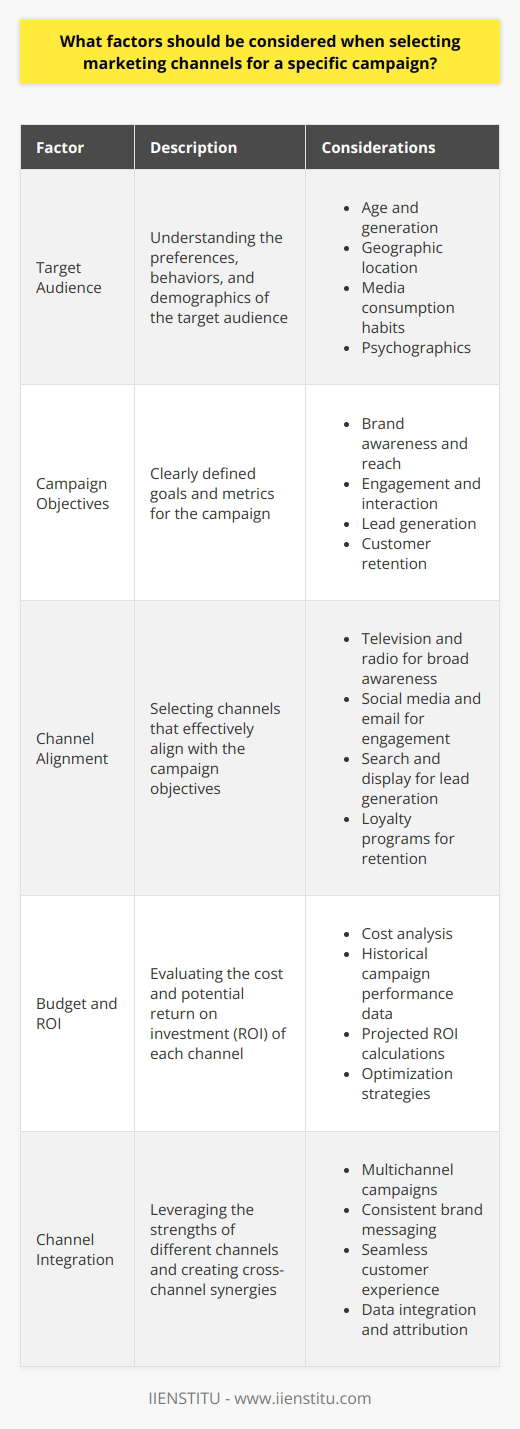
How can you effectively allocate resources across different marketing channels to optimize ROI?
Effectively allocating resources across different marketing channels to optimize ROI requires a strategic approach. This involves conducting thorough research, setting clear goals, and continuously monitoring and adjusting the allocation based on performance data. By understanding the target audience and their preferred channels, marketers can make informed decisions about where to invest their resources.
Set Clear Goals and Objectives
Before allocating resources, it's crucial to establish well-defined goals and objectives for the marketing campaign. These goals should align with the overall business objectives and be specific, measurable, achievable, relevant, and time-bound (SMART). Having clear goals helps guide resource allocation decisions and provides a benchmark for measuring success.
Conduct Market Research
To make informed resource allocation decisions, marketers must have a deep understanding of their target audience. Conducting market research helps identify the channels that the target audience uses most frequently and engages with most effectively. This information can guide decisions about where to allocate resources for maximum impact.
Analyze Historical Data
Analyzing historical data from previous marketing campaigns can provide valuable insights into channel performance. Look for patterns in customer behavior, conversion rates, and ROI across different channels. This data can help identify the most effective channels and inform future resource allocation decisions.
Prioritize Channels Based on Performance
Once you have gathered data on channel performance, prioritize the channels that deliver the highest ROI. Allocate a larger portion of the marketing budget to these high-performing channels while still maintaining a presence on other relevant channels. Regular monitoring and adjustment of resource allocation based on performance are essential for optimizing ROI.
Test and Experiment
Continuously test and experiment with different resource allocation strategies to find the optimal mix for your business. Conduct A/B tests, try new channels, and adjust the allocation based on the results. This iterative approach allows for fine-tuning the resource allocation strategy over time.
Leverage Analytics and Tracking Tools
Utilize analytics and tracking tools to monitor the performance of marketing campaigns across different channels. These tools provide valuable data on customer behavior, conversion rates, and ROI. Regular monitoring and analysis of this data enable marketers to make data-driven decisions about resource allocation and optimize campaigns for better results.
Focus on Customer Lifetime Value
When allocating resources, consider the customer lifetime value (CLV) associated with each channel. Channels that attract customers with higher CLV may warrant a larger resource allocation, even if the initial acquisition costs are higher. Long-term ROI should be a key consideration in resource allocation decisions.
Collaborate with Cross-Functional Teams
Effective resource allocation requires collaboration with cross-functional teams, such as sales, product development, and customer service. These teams can provide valuable insights into customer needs, preferences, and behaviors. Collaborating with these teams helps ensure that resource allocation decisions are aligned with overall business goals and customer needs.
By following these strategies and continuously monitoring and adjusting resource allocation based on performance data, marketers can effectively optimize ROI across different marketing channels. A data-driven, agile approach to resource allocation is essential for maximizing the impact of marketing investments and driving business growth.
